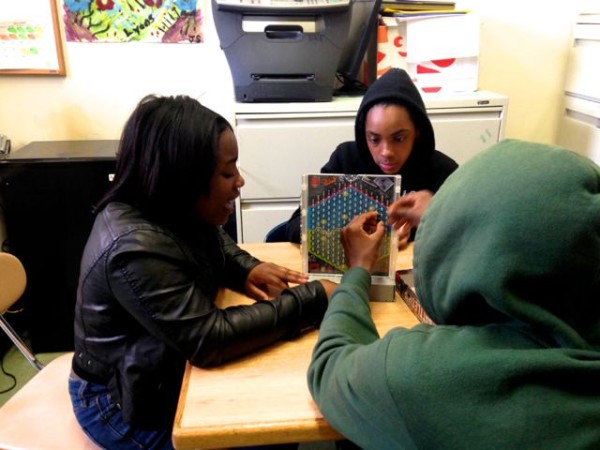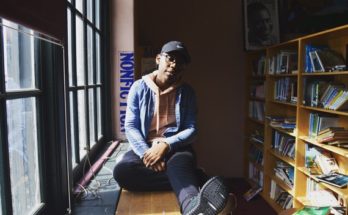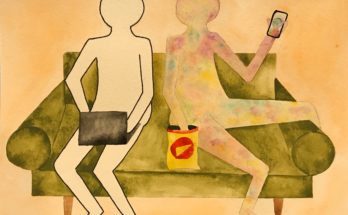
On a Monday afternoon, Kemi Karim, a lanky 10th- grader at Lyons Community School, was pulled out of class. She had no reason to be worried.
“I am a goody two-shoes,” she said. “I never get in trouble.”
Karim was serving on that day’s “justice panel,” a rotating group of students that addresses disciplinary incidents in the school. She headed to an empty classroom where three more students later joined her: 10th-grader Ezequiel Collado and 12th-graders, Rolman Guzman and Shanice Green.
The case before the students involved an eighth-grader who had smeared a bread roll covered in sauce over a sixth-grader’s face during lunch break. The panel’s task was to probe the cause of the incident and recommend a “consequence,” a way in which the eighth-grader could make up for her behavior.
The idea of repairing harm is central to restorative justice, a concept that drives justice panels such as the one at Lyons. The goal is for students to accept responsibility for their behavior and make amends for it by apologizing, resolving differences through dialogue, and doing community service. The school holds its panels at least twice a week.
Located in East Williamsburg — in an untrendy stretch between Williamsburg, Bushwick and Greenpoint — Lyons serves around 500 students who are overwhelmingly poor and 90 percent African American and Hispanic. Its switch to restorative justice methods is one of the main reasons the school’s suspension rate dropped from 22 percent seven years ago, to 3 percent last year. Lyons, a 6 through 12 school that is nearly 25 percent special needs, is one of at least four schools in New York City that are testing the justice panel idea as an alternative to suspending students.
Children’s advocates, teachers and principals have long argued that the old suspension ways are ineffective. A 2011 study in Texas found that one suspension more often that not leads to many, many more down the years. Not only does it not work to improve behavior, but students who are suspended often are also more likely to drop out of school, break the law and eventually end up in jail.
By using justice panels, student mentoring and peer-led conflict resolution, these experimental schools are trying to turn suspensions, which are now the most common disciplinary tool, into a last resort.
“This automatic response we have gotten into, get the bad kids out so the good kids can learn, get the bad kids out to where?,” said Judith Kaye, a former chief judge for the state of New York. Kaye, who believes that frequent suspensions can spur the “school to prison pipeline,” launched an independent task force in 2011 that focused on keeping students in the classroom and out of the courtroom.
“Kids should not be fighting in school, kids should not be talking back, kids should not be stealing from lockers,” said Kaye. “There should be some accountability for all misbehavior. But it’s just that we don’t need to do it so abusively and destructively and particularly so disproportionately.”
Unequal discipline
According to the task force’s report, suspensions and school-related arrests spiked after the 90s. At the same time, national pressure was on to implement “zero tolerance.” Originally designed to help fight drugs and gun violence in schools, the policy was increasingly used against children who broke minor rules.
Suspensions rose in New York City as well since 2000. In the school year 2012-13, schools suspended over 50,000 of their 1.1 million students. That was nearly double the number of those suspended in 2001-02. Enrollment in those years, however, fell.
Numbers from the New York City Department of Education show that suspensions are disproportionately given to black students and those with special needs. In 2012-2013, for instance, around a quarter of the students in the city’s public schools were black. But they received more than half the suspensions that year.
This is true across the U.S., according to a recent report from the Federal Department of Education’s Office of Civil Rights. Sixteen percent of black students are suspended in the country on average compared to five percent of white students.
In the last three years, however, suspensions have declined in New York City. Advocates claim that restorative justice, and similar efforts at “positive discipline” are one reason for the drop in numbers. They also believe that such alternatives are more effective.
“It’s not like we are giving the students leeway,” said Karim, who served on the justice panel several times. “It’s kind of like a second chance because a lot of the time when we bring kids to justice panel, they actually realize what they did wrong and they change and they don’t do it again.”
But getting students to appear before a justice panel is not always easy. The eighth-grader who was supposed to appear for assaulting another student with a bread roll, ended up sneaking out of school. So the panel interviewed the subdued sixth-grade victim, Amari Johnson, who explained that she had done nothing to provoke the smearing incident. And she hadn’t retaliated either, something the panel applauded.
“I understand the fact that she smeared sauce in your face, but if you would have reacted you would also be served consequences,” said Karim.
“It’s good that you didn’t react with violence because violence is bad,” added Collado. Recognizing that Johnson had controlled her emotions, they even clapped for her.
“We are proud of you for being responsible,” said Karim. “So don’t feel so bad.” Blushing at the unexpected praise, Johnson returned to class.
This was the second time the eighth-grader had avoided appearing before a justice panel. “She’s been cutting school all the time,” said Darron Burgos, the dean of students. “I called her family. No one came.”
Burgos, the recipient of the students’ “silent but deadly award” is one of five deans at Lyons. The deans also double up as staff assistants and coaches. Although they are known as deans, Burgos explained, they technically aren’t deans because the school’s budget doesn’t allow for that. Lyons has only two guidance counselors and no social worker.
Many public schools struggle with assigning enough resources to deal with students’ behavioral issues that may be related to problems at home or an underlying diagnosis for special needs.
Far from perfect
At Lyons too, students arrive at school with a “lot of things happening with their lives,” said Taeko Onishi, the school’ principal.
Dressed in a sweatshirt and knee-length skirt, her long hair left loose, Onishi is unusually casual for a principal. With her laptop perched on her arm, she is constantly on the move — circling the hallways, dropping into classrooms, and walking in and out of the cluttered staff room.
When she started the school seven years ago, she planned to use suspensions sparingly. “They (the students) interpreted that as, ‘oh we can do what we want to do,’” she said. So, despite its best intentions, the school suspended a lot of students. In 2008-09, it’s second year Lyons suspended 22 percent of its students, three times the city’s average of 6 percent.
“So we had to change what we were doing,“ said Onishi. “We created a culture where suspensions wouldn’t be a solution.” Student mentors work with younger students in need of individual guidance; peer-mediators break up arguments and resolve conflicts; justice panels made up of students investigate instances of misbehaver and decide how a student can compensate for it. The result: Lyons’ suspension rate dropped to three percent by 2011-12.
But restorative justice comes with its own difficulties. It requires, for instance, the student to take responsibility for his or her actions. Without such an acknowledgement, the panel cannot do what it does – find out the reason for the student’s misbehavior. Students also may feel uncomfortable in such a position.
“I don’t want to have these kids who may very well be this student’s friend or classmate trying to piece together whether they are telling the truth or not,” said Burgos.
Others, such as Janelle Stanley, a social worker at Harlem Renaissance High School, believe that restorative justice “forces intimacy” by expecting a student to discuss what prompted his or her misbehavior.
“Sometimes they need to hold it in,” said Stanley. “If they think they need to hold it in, I can’t force myself through that.” She recommended closely monitoring students’ behavior and working with them one-on-one. She uses this program, called Suspension Alternatives, at her high school, a transfer school in East Harlem.
But, Stanley admitted, no matter how many alternatives schools used, there will always be instances when they cannot avoid suspending a student. Onishi said the same.
“The goal is not to reduce suspensions,” said Onishi. “The goal is to help our kids and suspensions don’t help them.” There are times, she added, when suspension is an “effective tool.” But only if students are invested in the school: “If a kid doesn’t feel like they want to be someplace, suspensions don’t work.” Onishi’s hands-on approach drives Lyons’ commitment to restorative justice because she is personally committed to testing alternatives.
Principals have a fair amount of leeway under the current discipline code. The Department of Education (DOE) insists on suspending kids only in the case of Level 5 offenses, which include use of serious force, group violence, sale or distribution of controlled substances and possession of a weapon. For lesser offenses, which range from disrupting class to minor physical fights, the punishment is at the principal’s discretion.
At Lyons, students aren’t suspended out of school for minor offenses such as disrupting a class. Instead, they spend the duration of that class in the “dean’s room,” room 308.
The Dean’s Room
The square room with a single window serves as an office for the deans, a detention room for students who were sent out of class, and an escape for those who don’t want to attend class. The deans, all in their mid to late 20s, lock the door from inside to discourage the last group. It’s not uncommon to see the deans physically blocking students from entering or dragging them by the arm to push them out of the door, forcing them to attend class. But students were persistent. They banged on the door fervently or waited until the door opened to sneak in to the room. And the door opened often.
On a warm Friday morning around 9:30 a.m., Kamani Harrell was the first to walk in and flop down. The ninth grader had complained that he didn’t want to go on a camping trip with his class. The teacher, who was excited about the trip, asked him to stop “putting things down.” The two argued and Harrell had suddenly launched into an explosive rant.
“Do you remember anything you said?” asked Dan Espinoza, one of the deans. Tall with cropped hair, his golden watch flashing as he spoke, Harrell shook his head. No. He spent the rest of the first period in the dean’s room.
Yariel, an eighth-grader, was already there for disrupting a class. Harrell’s brother, Dysheen, turned up the following period because he was barred from going on a class trip for misbehaving. Princess, Kyra and Britney, all 11th graders, were sent to the room because they were talking and giggling in class. Naszeir, a sixth grader, tried his best to join the collection of kids, but was repeatedly barred because he just wanted to skip class.
The parade of kids kept coming. At noon, Eliajah Pena, a surly eighth-grader, entered the room. “Look at that ray of sunshine,” said one of the deans. She gave him half a smile. She sat in a corner, and nodded to music that blared from her iPod. She either looked down or stared straight ahead. She didn’t want to go to class, she said, because “it wasn’t interesting.” She couldn’t say which class that was because she didn’t know her schedule. “None of my classes are interesting to me,” she said. She wasn’t concerned about failing either – “I don’t care.”
At 2 p.m., Harrell was back because he was told not to attend one teacher’s class for the whole day.
He wanted to attend class, and was not happy. Harrell, who had been suspended often at Lyons has appeared before a justice panel, as well as served on one.
“I’d rather be in front of a justice panel than be suspended,” he said. “I don’t want to be home. We ain’t doing nothing at home.” The more time kids spent outside school, he said, the less likely they were to come back. “Like hanging out, outside school,” said Harrell. “They would rather be there than in school so they stop coming. I have seen it happen.”
Work in Progress
That’s the tough part, according to Onishi. “Too many schools are not engaging the kids,” she said. She believes it’s up to the school to build relationships with students that that are strong enough to weather suspensions.
“How do you work with them when they are gone? And how do you work with them when they are back?” she asked.
Some kids, she said, are in touch with their school and they want to come back. Other kids, Onishi added, are too attached to the school to get in to severe trouble. Virgen Torres, an eighth grader, said she prefers school to home. It takes her 30 minutes to walk home but she walks, she said, because it takes longer. Her temper landed her in trouble with teachers and fights with classmates.
“I always want to be right,” she said gravely. “I want to have the last word even when I am wrong.” If she felt like she was having a “bad day,” she went straight to the dean’s room. She was working with a student mentor, an 11th grader who was helping her control her temper.
But students like Carmen, Torres and Harrell, are not the school’s toughest charges. It’s students like Pena, who cut class and spent too much time outside. “She can’t see anything good happening in her future,” said Burgos, who doesn’t know how to reach her. “We talk. We talk about life. I make some breakthroughs.” But she was still skipping most of her classes and what worried him was that, on some days, she wasn’t turning up for school at all.
Although Lyons doesn’t see much gang-related violence, the deans said, it affected the school because it affected the students once they were out of school. One of the seventh graders was shot in the leg recently when he ended up in the “wrong place at the wrong time,” Espinoza said. It was an incident that involved two gangs. An eighth grader was arrested, a case of mistaken identity, he said, because his identical twin is a member of a gang.
Students in the dean’s office, those as young as 11 years, casually discussed gangs and shared stories and rumors of who was “jumped” recently. Lyons is yet to hear from a student who was arrested over a year ago for bringing a gun to school. “I think they linked it to a shooting,” said Espinoza.
“We see tons of success stories but we also see tons of things that aren’t working,” said Onishi. “You can’t give up because it isn’t working well, you have to keep at it.”
Students at Lyons feel just as strongly about restorative justice. Karim, who attended middle school elsewhere, said restorative justice gave students a change to explain their side of the story. “In my old school, if you did something wrong…even if you didn’t do something wrong, if you were accused of it, you till got in trouble for it,” she said.
Carmen, a 12th-grade whose last name has been withheld for reasons of privacy, said restorative justice turned her life around. She was arrested twice when she was a seventh-grader at Lyons. She and her friends had got into serious physical fights with a rival group of girls from school.
“I fought just to fight sometimes,” she said. She never went to jail because assault charges were dropped both times. But she went to an alternate learning center (ALC), schools for public school students who are suspended for more than six days. The second time she was arrested she was also sent to the Greenpoint Youth Court, where she still works, five years later. Around the same time, Lyons had started to implement restorative justice. That, she said, was a turning point.
“When they sat me down and spoke to me about it, then I started to realize and understand that I cannot do stuff like that because it was not only hurting me,” Carmen said. “It was hurting my school and it was hurting my mom.”
In the five years since, she has become a mentor for students who get into trouble. She is also a regular member of Lyons’ justice panel. She thinks of Onishi as her best friend.
“But don’t tell her I said that,” she quickly added.



